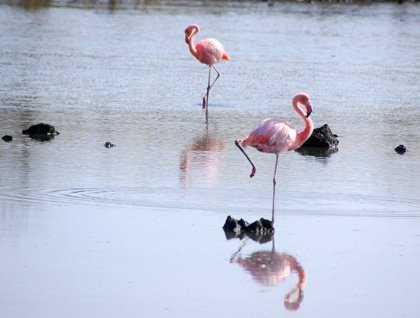After yesterday’s visit to the southern part of Santa Cruz Island, today we spent the day on the northwestern part of the island, visiting “Cerro Dragon” or “Dragon’s Hill” in the morning, home of the endemic Galapagos land iguanas. This particular population was almost wiped out by feral dogs in the sixties, but after a very successful captive and semi-captive breeding program run by the CDF and GNPS, the population is recovered and we are now privileged to be able to see these magnificent reptiles in the wild once more.
This visitor site is also home of white sand beaches, forests of giant prickly pear cacti and incense trees and a small lagoon where often, like today, we encounter shore birds, such as whimbrels, stilts, white checked pintail ducks and flamingos. The trail here took us along the brackish lagoon and then inland into the land iguana territory. The terrain was rocky and the vegetation was very dry, it was hot and humid, but we were able to spot five land iguanas, some were resting while others were in the shade and a couple were trying to feed on the cactus. Amazing to see how these animals adapted perfectly to this very dry and difficult environment.
After the walk, we returned back to the ship and immediately we went for an adventurous deep-water snorkel trip to the offshore Guy Fawkes Islets, where we were able to enjoy some sea lions in the water as well as large schools of the yellow tailed razorfish and an incredible array of colors of all the invertebrates attached to the rocks and the cliffs.
After a very succulent Ecuadorian buffet lunch, we sailed south to a lovely stretch of the eastern shore of Santa Cruz known as “El Eden” that we explored by kayaks and by Zodiac rides, while our young explorers enjoyed some Zodiac riding lessons.
Once back onboard, at around 4:00 p.m. we sailed north to the famous Daphne Major Islet. This islet became well known as the natural laboratory of the Darwin finches after British scientists Peter and Rosemary Grant of Princeton University began studying the ecology of Darwin’s finches there. The studies went on for more than 30 years and continue to this day. Observations they have made during this time have revolutionized the way we understand natural selection and how evolution occurs.







